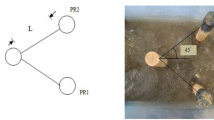Abstract
Construction of river diversion barrages produces a shallow reservoir, called the pond, which is used more often for flow balancing between the inflows of the river and the outflows of the off-taking canal. However, deposition of sediment in the pond due to the relatively low velocities reduces the pond capacity. The current study investigates the effectiveness of gate operation and variations of other parameters in flushing out these sediment mounds, or shoals, from the barrage pond. Data from laboratory experiments on a scaled model of a prototype barrage is used to train and test different Artificial Neural Network (ANN) models of the system. The models map the relationship between flushing efficiency of a sediment shoal from the upstream of a barrage, and the parameters river discharge, barrage pond depth and area of gate opening, position of the sediment shoal with respect to the barrage. The ANN models are then used to study the effect of different parameters on the sediment flushing efficiency. Apart from river discharge and net area of gate opening, upstream pond depth is also found to have a significant effect on flushing efficiency, with a general trend of decrease in efficiency with increase in pond depth becoming apparent. Efficacy of different gate opening pattern is also tested, with the ‘inverted arch’ gate opening pattern proving to be the most efficient when compared with ‘arch’ and ‘uniform’ gate opening.


















Similar content being viewed by others
References
Annandale GW (1987) “Reservoir Sedimentation”. Elsevier Science Pub. Co., USA
ASCE Task Committee (2000a) Artificial neural networks in hydrology. I: preliminary concepts. J Hydrologic Eng ASCE 5(2):115–123
ASCE Task Committee (2000b) Artificial neural networks in hydrology. II: preliminary hydrology applications. J Hydrologic Eng ASCE 5(2):124–137
Azmatullah HM, Deo MC, Deolalikar PB (2005) “Neural networks for estimation of downstream of Ski-jump bucket”. J of Hydraul Eng ASCE 131(10):898–908
BIS (1989) Guidelines for hydraulic design of barrages and weirs: (IS 6966 Part 1) alluvial reaches. Bureau of Indian Standards, New Delhi
Brandt SA (1999) Reservoir Desiltation by Means of Hydraulic Flushing. Ph. D. Thesis, Institute of Geography, Faculty of Science, University of Copenhagen, Denmark
CBIP (1981) Barrages in India, publication 148. Central Board of Irrigation and Power, New Delhi
CBIP (1985a) Manual on barrages and weirs on permeable foundations, volume-1. Central Board of Irrigation and Power, New Delhi
CBIP (1985b) Manual on barrages and weirs on permeable foundations, volume-2. Central Board of Irrigation and Power, New Delhi
Dietrich J, Hangstrom A, and Navntoft E (1983) Studies of the effect of a barrage on sedimentation., Int. Conf. on Coastal and Port Engineering in Developing Countries, Colombo, Sri Lanka, 1218–1232
Ghosh MK (2008) Donwnstream Local Scour and Sediment Flushing Characteristics of Diversion Barrages, Ph. D. Thesis, Indian Institute of Technology, WB, India
Holz P, and Heyer H (1989) Sedimentation in a barrage protected tidal river., Proc. 23rd Int. Congress of IAHR, Int. Association for Hydraulic Research, Ottawa, Canada, 241–247
Ji U, Julien PY, Park SK (2011) Sediment flushing at the Nakdong river estuary barrage. J Hydraul Eng 137(11):1522–1535
Kantoush SA, Bollaert EFR, Boillat J-L, Schleiss AJ (2005) Sedimentation Processes in Shallow reservoirs with different geometries., Proc. of 8th International Conference on Fluvial Sedimentology, August 7–12, 2005, Delft, The Netherlands, 2005
Kantoush SA, Bollaert E, Boillat JL, and Schleiss A (2006) Experimental and numerical modeling of sedimentation in rectangular shallow reservoirs: a first comparison., Journal of sedimentary geology, Elsevier
Leliavsky S (1955) Irrigation and hydraulic design. Chapman & Hall Ltd. 37, London
MATLAB (2003) Neural network tool box version 4.0, The Math works, Inc., Matick, Mass
Mazumder SK (2011) Breaching of flood embankments with particular reference to kosi and farakka barrages in India. Journal of Water Energy International by Central Board of Irrigation & Power, New Delhi
Morris GL, Fan J (1997) Reservoir sedimentation handbook: design and anagement of dams, reservoirs, and watersheds for sustainable use. McGraw-Hill, New York
Novak P, Moffat AIB, Nalluri C, and Narayanan R (2007) Hydraulic Structures. Taylor and Francis Publication., UK
Olesen KW, and Basson GR (2004) “1D and 2D modelling of sedimentation and flushing in shallow reservoirs.” 9th International Symposium on River Sedimentation., Three Gorges Dam Hotel, Yichang, China, Tsinghua University Press, 1057–1064
Olsen NRB (1997) “Computational Fluid Dynamics as a tool for prediction of reservoir flushing and sedimentation”, Q 74 a), ICOLD Conference, Florence, Italy
Olsen NRB (1999) “Two-dimensional numerical modelling of flushing processes in water reservoirs”, IAHR Journal of Hydraulic Research, No. 1
Olsen NRB (2000) “CFD modelling of bed changes during flushing of a reservoir”. Hydroinformatics 2000, Iowa
Rojas R (1996) Neural networks. Springer Verlag, Berlin
Schmidt T, Brudy-Zippelius T, Kopmann R, Imiela M (2005) Investigations to reduce sedimentation upstream of a barrage on the river Rhine. WIT Trans Ecol Environ 80:145–154
Sen P (1989) “Effect of Human Interference on the alluvial river morphology.”, J. of Irrigation and Power, Central Board of Irrigation and Power, New Delhi, India, 15–26
Singh VP, Yadava RN (2003) Water resources system operation. Allied Publishers (ISBN 817764548X), New Delhi
Sinha CP, Sharma N, and Mohanty NC (1985) Study of looseness factor for barrages., 53rd Annual R&D Session, CBIP, Technical session 1 paper no. 10, India
Westrich B, Muller P (1983) Numerical modeling of morphological change of a river bed due to barrages. International Association for Hydraulic Research, Moscow, pp 428–435
Yossef MFM (2005) Morphodynamics of rivers with gryones, Ph. D. Thesis, Delft University, Netherlands
Acknowledgments
The authors would like to thank the staff at the Hydraulics Lab of Indian Institute of Technology Kharagpur, India, for their assistance during the laboratory experiments. The authors would also like to thank the two anonymous reviewers for the thorough and fair review of the study, which we think has help improve this article.
Author information
Authors and Affiliations
Corresponding author
Rights and permissions
About this article
Cite this article
Ghosh, M.K., Dutta, S. & Sen, D. Sediment Flushout from Pond of River Diversion Barrages by Gate Operation. Water Resour Manage 28, 5335–5356 (2014). https://doi.org/10.1007/s11269-014-0804-y
Received:
Accepted:
Published:
Issue Date:
DOI: https://doi.org/10.1007/s11269-014-0804-y




